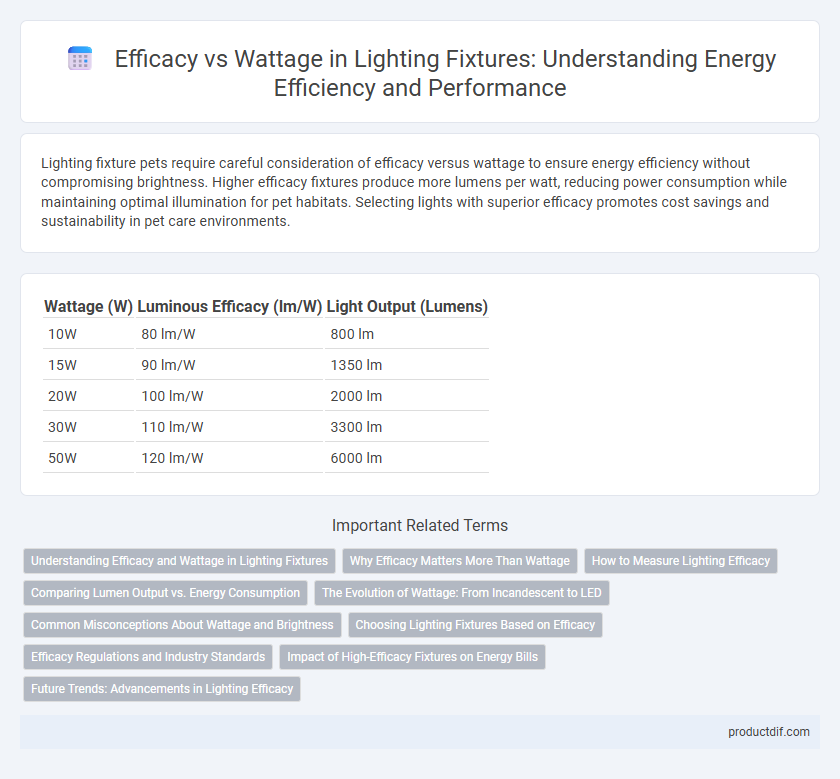Lighting fixture pets require careful consideration of efficacy versus wattage to ensure energy efficiency without compromising brightness. Higher efficacy fixtures produce more lumens per watt, reducing power consumption while maintaining optimal illumination for pet habitats. Selecting lights with superior efficacy promotes cost savings and sustainability in pet care environments.
Table of Comparison
| Wattage (W) | Luminous Efficacy (lm/W) | Light Output (Lumens) |
|---|---|---|
| 10W | 80 lm/W | 800 lm |
| 15W | 90 lm/W | 1350 lm |
| 20W | 100 lm/W | 2000 lm |
| 30W | 110 lm/W | 3300 lm |
| 50W | 120 lm/W | 6000 lm |
Understanding Efficacy and Wattage in Lighting Fixtures
Efficacy in lighting fixtures measures the amount of light produced per watt consumed, expressed in lumens per watt (lm/W), providing a key indicator of energy efficiency. Wattage indicates the electrical power drawn by the fixture but does not directly reflect brightness or energy efficiency. Understanding the distinction between efficacy and wattage enables better selection of lighting fixtures that balance energy consumption with desired luminosity.
Why Efficacy Matters More Than Wattage
Efficacy, measured in lumens per watt (lm/W), quantifies how efficiently a lighting fixture converts electrical power into visible light, making it a critical metric beyond mere wattage. High-efficacy fixtures deliver more brightness while consuming less energy, directly impacting energy savings and long-term operational costs. Wattage alone fails to indicate performance quality, as two fixtures with identical wattage can have vastly different light outputs and energy efficiencies, emphasizing the importance of prioritizing efficacy in lighting design.
How to Measure Lighting Efficacy
Lighting efficacy is measured by calculating the ratio of luminous flux (lumens) emitted by a fixture to the electrical power consumed (watts), expressed as lumens per watt (lm/W). To accurately assess lighting efficacy, use a calibrated integrating sphere or goniophotometer to capture total light output while monitoring real power consumption with a reliable wattmeter. Comparing lumens per watt helps determine how effectively a lighting fixture converts electricity into visible light, optimizing energy savings and performance.
Comparing Lumen Output vs. Energy Consumption
Lumen output measures the brightness produced by a lighting fixture, while wattage indicates the energy consumed. Higher lumens per watt reflect superior efficacy, meaning more light is generated for less energy used. Comparing these values helps identify energy-efficient fixtures that deliver optimal illumination with minimal power consumption.
The Evolution of Wattage: From Incandescent to LED
Wattage has evolved significantly from incandescent bulbs, which consumed high watts with low efficacy, to modern LED fixtures that deliver superior lumens per watt, drastically reducing energy consumption. LED lighting fixtures often achieve efficacies above 100 lumens per watt, contrasting with incandescent bulbs averaging around 10-17 lumens per watt. This evolution in wattage efficiency has revolutionized lighting design, enabling brighter illumination with minimal energy use and longer fixture lifespan.
Common Misconceptions About Wattage and Brightness
Wattage measures the energy consumption of a lighting fixture, not its brightness, which is determined by lumens. Many consumers mistakenly equate higher wattage with more light output, ignoring that modern LED fixtures offer high efficacy by producing more lumens per watt. Understanding lumens and fixture efficacy enables better choices for energy efficiency and optimal illumination.
Choosing Lighting Fixtures Based on Efficacy
Selecting lighting fixtures based on efficacy ensures optimal energy consumption by measuring lumens per watt, indicating how efficiently a fixture converts power into visible light. Fixtures with high efficacy ratings provide brighter illumination while using less electricity, reducing operational costs and environmental impact. Prioritizing luminaire efficacy over wattage guarantees smarter lighting decisions that enhance both performance and energy efficiency.
Efficacy Regulations and Industry Standards
Lighting fixture efficacy regulations and industry standards focus on maximizing lumens per watt to improve energy efficiency and reduce environmental impact. Key standards, such as DOE regulations and ENERGY STAR certifications, set minimum efficacy requirements that lighting manufacturers must meet, driving innovation in LED technology and reducing overall power consumption. Compliance with these regulations ensures fixtures deliver sufficient brightness while minimizing wattage, aligning with global efforts for sustainable energy use.
Impact of High-Efficacy Fixtures on Energy Bills
High-efficacy lighting fixtures deliver more lumens per watt, significantly reducing electricity consumption without compromising brightness. Switching to LED fixtures with efficacy ratings above 150 lumens per watt can lower energy costs by up to 50% compared to traditional incandescent bulbs. The initial investment in high-efficacy lighting typically results in rapid payback through decreased utility bills and lower maintenance expenses.
Future Trends: Advancements in Lighting Efficacy
Future trends in lighting efficacy emphasize breakthroughs in LED technology, enabling fixtures to achieve higher lumens per watt, thus reducing energy consumption without compromising brightness. Emerging innovations such as organic LEDs (OLEDs) and smart lighting controls further enhance efficacy by optimizing light output and minimizing waste. These advancements contribute to sustainable lighting solutions, aligning with global energy efficiency standards and reducing overall operational costs.
Efficacy vs wattage Infographic

 productdif.com
productdif.com